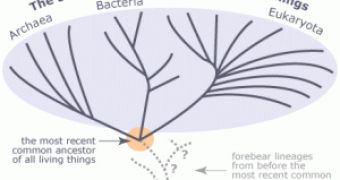Scientists have now identified so many possible scenarios for how life could have developed from organic molecules that the debate has moved from the issue of the possibility of the origin of life to the problem of determining which of these scenarios has actually happened. The chemical processes that lead to the synthesis of prebiotic molecules are so abundant that ancient Earth must have had far more different kinds of molecules than could have been used by early life. Moreover, astronomers have discovered that organic substances can even form in the outer space.
The situation in the early Earth looked something like this: Biomolecules which had formed in the molecular clouds in deep space rained down on the planet. Molecular synthesis driven by lightning and ultraviolet radiation happened in the atmosphere. Volcanic heat drove chemical reactions in the deep oceans.
Scientists now think that the first signs of life have appeared from these organic building blocks when they have got stuck on certain mineral surfaces. On these surfaces they collected, concentrated, and underwent further reactions which lead to the appearance of amino acids (the building blocks of proteins) and nucleic acids (like DNA). Previous studies investigated the strength of the bounds between the mineral surface and the organic molecules in volcanic ponds.
Now, an interdisciplinary team of researchers led by Robert Hazen, of the Carnegie Institution's Geophysical Laboratory and former president of the Mineralogical Society of America, has developed new protocols and procedures for adapting DNA microarray technology to rapidly identify promising molecule/mineral pairs.
"Some 20 different amino acids form life-essential proteins," Hazen explained. "In a quirk of nature, amino acids come in two mirror-image forms, dubbed left and right-handed, or chiral molecules. Life, it turns out, uses the left-handed varieties almost exclusively. Non-biological processes, however, do not usually distinguish between left and right variants. For a transition to occur between the chemical and biological eras, some process had to separate and concentrate the left- and right-handed amino acids. This step, called chiral selection, is crucial to forming the molecules of life."
Hanzen and his colleague think that maybe the chiral selection was a consequence of the properties of the mineral surfaces on which the initial organic molecules got stuck. For example calcite, a common mineral which was also prevalent during the Archean Era when life first emerged, also comes in two forms. In 2001, Hanzen and colleagues have discovered that the left-handed amino acid, aspartic acid, adheres predominantly to left-faced calcite.
This connection between the properties of minerals and the left-handiness of life's amino-acids opens a door for discovering in what conditions exactly life has actually appeared. So, now the challenge is to determine which of the countless biomolecules/surface interactions are the most likely candidates to the first steps to life.
"Crystal surfaces are complicated," Hazen explained. "They have crevices and craters, and are seldom flat. We need to find which surface types are the best 'docking stations' for different biomolecules. However, there are hundreds of mineral surface types and thousands of plausible prebiotic molecules, making literally millions of possible biomolecule/mineral pairs. It's an overwhelmingly large number of possibilities."
There are so many possibilities that one needs a smart technology to check them all as fast as possible. This technology does exist and involves the use of DNA microarrays. Such microarrays are produced robotically and are used in biotechnology research having literally revolutionized the field. They are used for example to identify the genes involved in disease. Scientists can create a slide that contains many fragments of DNA, each in its own cell on the array and then detect the content of which cell changes. Scientists can thus determine which genes are turned on.
Hazen, working with Carnegie staff scientist Andrew Steele and his team, has now modified this tool to study molecule/mineral interactions. The array can simulate the mineral surface and can be filled with up to 96 different organic species. Washing the array allows one to determine which organic molecule sticks to which kind of surface.
"In many ways, Hazen's approach cuts to the chase of addressing this problem," said Patricia Dove, professor of geochemistry at Virginia Tech. "By adapting the microarray approach from molecular biology, his research group can identify up to one million types of biomolecules very quickly to learn which have the strongest interactions with mineral surfaces. It doesn't stop there though - another real advance lies in analyzing their experiments by the ToF-SIMS. This eliminates the need for chemical tags whose own properties could influence the results."
The "ToF-SIMS" she refers to is Time-of-Flight Secondary Ion Mass Spectrometry. This is a great chemical instrument which is a further development of mass spectroscopy - the method of determining the chemical composition of something by breaking it apart and measuring the masses of the pieces. The ToF-SIMS blasts a sample with ionized particles and fragments the surface-bound molecules and topmost mineral layer. Then, the mass spectrometer determines what's there. "ToF-SIMS will also allow us to detect the organic molecules that bind most strongly to mineral surfaces," said Hazen.
"What's particularly rewarding about this research is that it's an interdisciplinary effort from different areas of science--biology, chemistry and geology," he said. "It marries them to search for an answer to a question that has intrigued humanity since the birth of consciousness: How did we get here?"
Now we have to wait and see what this very ambitious research will bring. It will potentially answer the question of how the organic compounds present in the early Earth environment have concentrated to initiate the primitive versions of metabolism and of reproduction.

 14 DAY TRIAL //
14 DAY TRIAL // 

